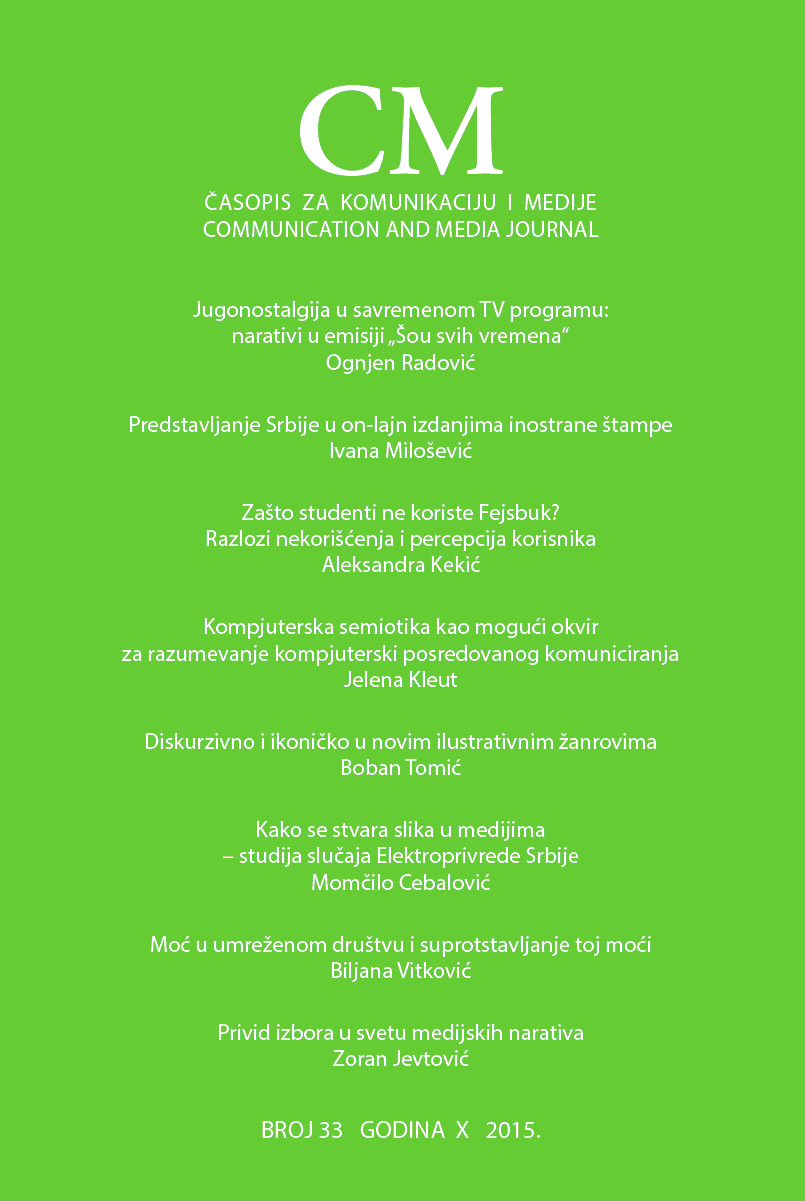Discursivity and iconicity of new illustrative genres
Abstract
Modern business conditions in the media market, as well as the development of professional technologies in the field of press, television and online media, are requiring a significant commitment to creative and innovative processes. The formal and content related structure of visual media, especially the press, television and online media, are experiencing dynamic changes and improvements, mainly based on innovations in the fields of computer technology, modelling of sound and images, as well as graphic design. In such circumstances, in addition to improving the form, content and expressive possibilities illustrative of some of the classic genres, such as photos, illustrations, cartoons, graphs or tables, there are new forms of illustrative character. The emergence of infographics, and development of live-diagrams and visual maps are significantly improving visual communication in the media and becoming the actual media content in print, television and online media. This paper describes and analyses the creative processes and technology components contributing to the emergence and development of new illustrative forms, as well as the needs of their use in the current media practice. We point out the potential that new illustrative genres entries have in the process of mass communication, but also in business practices and results of operations of media companies. Using some representative samples and illustrative examples of the development of the genre, we point to the deficiencies and anomalies that contemporary illustrative form can bring to journalists, editors and their audience. The starting point of this paper is the idea that the development of visual forms of communication must not make vulgar simplification of content of media messages, but the messages should be enriched. Journalism must serve the new illustrative genres in order to increase the informational value of media content, but not at the expense of the discursive form and content.
References
Anderson, A. D., Itjul, D. B. (2001). Pisanje vesti i izveštavanje za današnje medije. Beograd: Medija centar.
Bart, R. (2011). Svetla komora, beleška o fotografiji. Beograd: Kulturni centar Beograda.
Brigs, A. i Berk, P. (2006). Društvena istorija medija. Beograd: Clio.
Chandler, D. & Munday, R. (2011). Dictionary of Media and Communication. New York: Oxford University Press, Inc.
Harcup, T. (2014). Dictionary of Journalism. Oxford: Oxford University Press.
Jevtović, Z., Petrović, R., Aracki, Z. (2014). Žanrovi u savremenom novinarstvu. Beograd: Jasen.
Lowgren, J. & Reimer, B. (2013). Collaborative Media. Production, Consumption, and Design Interventions. Cambridge, London: The MIT Press.
Radojković, M. i Miletić, M. (2006 ). Komuniciranje mediji i društvo. Novi Sad: Stylos.
Rus-Mol, Š. i Zagorac Keršer, A. (2014). Novinarstvo. Beograd: Clio, Radio-televizija Srbije.
Sontag, S. (2009). O fotografiji. Beograd: Kulturni centar Beograda.
Šnel, R. 2008). Leksikon savremene kulture. Beograd: Plato.
Tufte, E. (1983). The Visual Display of Quantitative Information. Cheshire, Connecticut: Graphics Press.
Đorđević, T. (2007). Teorija masovnih komunikacija. Beograd: Institut za političke studije.
Machin, D. & Polzer, L. (2015). Visual Journalism. Hampshire: Palgrave, Macmillan education.
Marković, D., Cvetković, D., Kostić, Z., Tasić, A. (2009). Osnovi grafičkog dizajna. Beograd: Univerzitet Singidunum.
Makluan, M. (1978). Poznavanje opštila – čovekovih produžetaka. Beograd: Prosveta.
Malović, S. (2003). Novine. Zagreb: Sveučilišna knjižara.
Negroponte, N. (1996). Being Digital. New York: Vintage Books.
Rudin, R. & Ibbotson, T. (2008). Novinarstvo, osnovne tehnike i temeljna znanja. Zagreb: Mate, doo.
Copyright
Authors retain copyright of the published papers and grant to the publisher the non-exclusive right to publish the article, to be cited as its original publisher in case of reuse, and to distribute it in all forms and media.
Licensing
The published articles will be distributed under the Creative Commons Attribution ShareAlike 4.0 International license (CC BY-SA). It is allowed to copy and redistribute the material in any medium or format, and remix, transform, and build upon it for any purpose, even commercially, as long as appropriate credit is given to the original author(s), a link to the license is provided, it is indicated if changes were made and the new work is distributed under the same license as the original.
Users are required to provide full bibliographic description of the original publication (authors, article title, journal title, volume, issue, pages), as well as its DOI code. In electronic publishing, users are also required to link the content with both the original article published in CM: Communication and Media and the licence used.
Authors are able to enter into separate, additional contractual arrangements for the non-exclusive distribution of the journal's published version of the work (e.g., post it to an institutional repository or publish it in a book), with an acknowledgement of its initial publication in this journal.
Self-archiving policy
Authors are permitted to deposit author’s publisher's version (PDF) of their work in an institutional repository, subject-based repository, author's personal website (including social networking sites, such as ResearchGate, Academia.edu, etc.), at any time after publication.
Full bibliographic information (authors, article title, journal title, volume, issue, pages) about the original publication must be provided and links must be made to the article's DOI and the license.
Disclaimer
The views expressed in the published works do not express the views of the Editors and the Editorial Staff. The authors take legal and moral responsibility for the ideas expressed in the articles. Publisher shall have no liability in the event of issuance of any claims for damages. The Publisher will not be held legally responsible should there be any claims for compensation.

